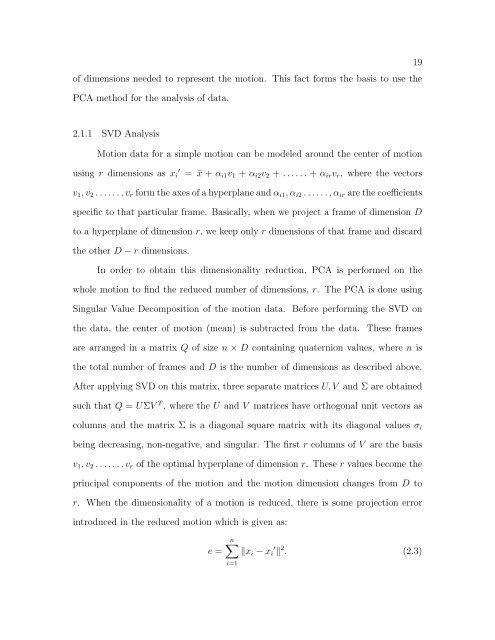A COMPARISON AND EVALUATION OF MOTION INDEXING ...
A COMPARISON AND EVALUATION OF MOTION INDEXING ...
A COMPARISON AND EVALUATION OF MOTION INDEXING ...
You also want an ePaper? Increase the reach of your titles
YUMPU automatically turns print PDFs into web optimized ePapers that Google loves.
of dimensions needed to represent the motion. This fact forms the basis to use the<br />
PCA method for the analysis of data.<br />
2.1.1 SVD Analysis<br />
Motion data for a simple motion can be modeled around the center of motion<br />
using r dimensions as xi ′ = ¯x + αi1v1 + αi2v2 + . . . . . . + αirvr, where the vectors<br />
v1, v2 . . . . . . , vr form the axes of a hyperplane and αi1, αi2 . . . . . . , αir are the coefficients<br />
specific to that particular frame. Basically, when we project a frame of dimension D<br />
to a hyperplane of dimension r, we keep only r dimensions of that frame and discard<br />
the other D − r dimensions.<br />
In order to obtain this dimensionality reduction, PCA is performed on the<br />
whole motion to find the reduced number of dimensions, r. The PCA is done using<br />
Singular Value Decomposition of the motion data. Before performing the SVD on<br />
the data, the center of motion (mean) is subtracted from the data. These frames<br />
are arranged in a matrix Q of size n × D containing quaternion values, where n is<br />
the total number of frames and D is the number of dimensions as described above.<br />
After applying SVD on this matrix, three separate matrices U, V and Σ are obtained<br />
such that Q = UΣV T , where the U and V matrices have orthogonal unit vectors as<br />
columns and the matrix Σ is a diagonal square matrix with its diagonal values σi<br />
being decreasing, non-negative, and singular. The first r columns of V are the basis<br />
v1, v2 . . . . . . , vr of the optimal hyperplane of dimension r. These r values become the<br />
principal components of the motion and the motion dimension changes from D to<br />
r. When the dimensionality of a motion is reduced, there is some projection error<br />
introduced in the reduced motion which is given as:<br />
e =<br />
n<br />
i=1<br />
19<br />
xi − xi ′ 2 . (2.3)
















